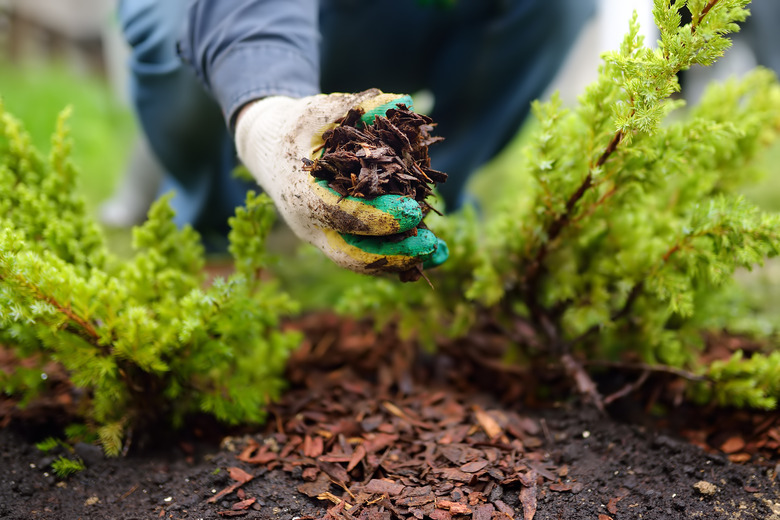Do You Need Weed Barrier If You Put Down Mulch?
We may receive a commission on purchases made from links.
In the battle against pesky weeds, you want all the help you can get, which is why you might consider putting down weed barrier cloth under mulch. Landscape fabric helps to prevent weed seeds from growing, but it still lets air and water reach plant roots in your landscaped areas. But some gardeners prefer to create dynamic living soil and believe organic mulch is the only weed barrier you need. Looking at the pros and cons of weed barrier cloth helps you decide if you should put it down under your mulch.
Tip
You can put down mulch without weed barrier cloth, but using it with the mulch may give you more protection against weeds.
Mulch and Its Many Purposes
Mulch and Its Many Purposes
One of the reasons to apply mulch is to prevent weeds. Mulch does that by blocking light. Plants, roots or seeds that might otherwise grow or germinate cannot do so without sunlight. Inorganic mulches include plastics and woven weed-barrier fabric. Most plastic mulches are covered with another material for aesthetic reasons, but also to delay the break-down of plastic from sun exposure.
Organic mulches include tree bark, straw, compost and grass clippings, usually applied in layers several inches thick. They need to be replenished periodically because of natural decomposition. Natural mulches also help prevent soil erosion, conserve water in soils and "feed" soil by releasing nutrients through steady decay. Some gardeners use thick layers of cardboard or newspaper mulch beneath other organic mulches to more effectively beat weeds and also build their soil.
Benefits of Weed Barrier Cloth
Benefits of Weed Barrier Cloth
There's no question that weed barrier cloth has its fans. Unlike black plastic, which is impermeable, woven landscape or weed-barrier cloth allows at least some air, water and soil nutrients to reach the soil, yet blocks light and restricts growth, therefore suppressing weeds. Garden professionals and some homeowners like to use it because they can block weeds without drying out the underlying ground or completely killing soil microorganisms. They also don't need to add tree bark or other decorative landscape mulches as frequently, because the barrier cloth prevents mulch contact with soil and slows its decomposition.
Drawbacks of Weed Barrier Cloth
Drawbacks of Weed Barrier Cloth
Despite preventing weeds, landscape fabric can disrupt natural processes that keep your garden healthy. Earthworms help aerate your soil naturally to prevent it from becoming too compact, but they can't survive in areas with landscape fabric since they can't reach the soil's surface. You also miss out on the natural decomposition of organic mulches, such as leaves and wood chips, which add nutrients to the soil.
While the fabric blocks weeds from growing underneath, it doesn't always stop weeds from taking root in the mulch on top of the fabric. This is more likely when you use wood chips or other organic mulches since they decompose and give the weed seeds a place to grow. You can also still have weeds grow from the ground if you don't install the weed barrier cloth correctly. Gaps in the fabric can let in sunlight and give the weeds a way to reach the surface.
How to Decide
How to Decide
Even advocates of weed barrier cloth admit it has limitations, especially when you add inches of mulch on top for a natural look. Weeds seeds often get trapped in the surface material and sprout above the barrier cloth, thereby defeating the cloth's main purpose. Sometimes shrub or plant roots will also start growing above the cloth instead of beneath it, or get hopelessly entangled in it, ultimately damaging the permanent plants you meant to help.
But there are some very good uses for weed barrier cloth, including rolling it beneath gravel or mulched walkways and under permeable patio paving to prevent weed growth and to stabilize the walking surfaces. Whether you use it in landscaping beds ultimately depends on you own choice.
Prevent Weeds First
Prevent Weeds First
In addition to mulching to prevent weeds, whether with organic, natural mulches or inorganic mulches such as weed barrier fabric, prevent weeds in the first place by making sure you don't inadvertently introduce them with topsoil or "uncooked" compost. Clean the area well before mulching, ensuring you remove as many weeds as possible first. Pull annual and perennial weeds as soon as you see them, pulling them out by the roots before they go to seed.
